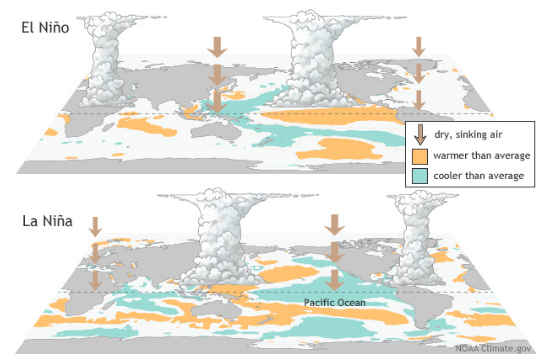Context:
The development of a positive Indian Ocean Dipole (IOD) has led to optimistic expectations regarding its ability to counterbalance the El Nino effect.
About El Nino:
- El Nino, meaning “the little boy” in Spanish is commonly known, refers to an abnormal warming of surface waters in equatorial Pacific Ocean. It is known to suppress monsoon rainfall.
- It was first noticed by scientists in the 1920s.
- It occurs on average every two to seven years, and episodes usually last nine to 12 months.
- Formation:
- It forms when the trade winds blowing east-to-west along the equatorial Pacific slow down or reverse as air pressure changes, although scientists are not entirely sure what kicks off the cycle.
- Because the trade winds affect the sun-warmed surface waters, a weakening causes these warm western Pacific waters to slosh back into the colder central and eastern Pacific basins.
- Impacts:
- El Niño events are typically associated with increased rainfall in parts of southern South America, the southern United States, the Horn of Africa and central Asia.
- In contrast, El Niño can also cause severe droughts over Australia, Indonesia, and parts of southern Asia.

Image Credits: NOAA Climate.gov
La Nina:
- La Niña means Little Girl in Spanish. La Niña is also sometimes called El Viejo, anti-El Niño, or simply “a cold event.
- It is opposite of EL Nino, which is the abnormal cooling of sea surface waters in the same region, and is known to aid rainfall over India.
- The La Nina phenomenon was discovered only in the 1980s.
- Mechanism for La Nina Formation:
- During La Niña events, trade winds are even stronger than usual, pushing more warm water toward Asia.
- Off the west coast of the Americas, upwelling increases, bringing cold, nutrient-rich water to the surface.
- These cold waters in the Pacific push the jet stream northward. This tends to lead to drought in the southern U.S. and heavy rains and flooding in the Pacific Northwest and Canada.
- During a La Niña year, winter temperatures are warmer than normal in the South and cooler than normal in the North. La Niña can also lead to a more severe hurricane season.
- During La Niña, waters off the Pacific coast are colder and contain more nutrients than usual.
- Impact:
- Western Pacific: Increased potential for landfall in vulnerable areas, particularly continental Asia and China.
- Heavy floods in Australia
- Increased temperatures in Western Pacific, Indian Ocean and off the Somalia Coast.
- South America: Drought in the South American countries of Peru and Ecuador.
El Nino Southern Oscillation (ENSO):
- There is a third, neutral phase, in which the sea surface temperatures remain roughly in line with long-term averages.
- Together, these three phases in the Pacific Ocean are referred to as El Nino Southern Oscillation, or ENSO.
Indian Ocean Dipole (IOD):
- IOD, sometimes referred to as the Indian Nino, is a similar phenomenon to El Nino, playing out in the relatively smaller area of the Indian Ocean.
- Affected Region: Between the Indonesian and Malaysian coastline in the east and the African coastline near Somalia in the west.
- A positive IOD event is often seen developing at times of an El Nino, while a negative IOD is sometimes associated with La Nina.
- It involves a temperature difference between the western and eastern sides of the Indian Ocean.
- Positive IOD: In it, warmer than average sea surface temperatures occur in the western Indian Ocean, particularly near the African coastline, while cooler than average temperatures are observed in the eastern Indian Ocean near Indonesia. This creates a gradient in sea surface temperatures across the Indian Ocean.
- Negative IOD: In a negative IOD event, the opposite occurs. Warmer than average SST is found in the eastern Indian Ocean, while cooler than average sea surface temperatures is observed in the western Indian Ocean.
Relation between IOD and El Niño:
- While the IOD and El Niño occur in different ocean basins, they can influence each other’s behaviour.
- Research suggests that strong El Niño events can enhance positive IOD conditions, increasing the likelihood of a positive IOD event in the Indian Ocean.
- Conversely, a positive IOD can impact the development and intensity of El Niño events.
- The interactions between the IOD and El Niño are complex and can vary, making it important for climate scientists to study and understand the relationships between these phenomena to improve climate predictions and forecasting.
Impact of IOD:
- A positive IOD helps rainfall along the African coastline and also over the Indian sub-continent while suppressing rainfall over Indonesia, southeast Asia and Australia.
- The impacts are opposite during a negative IOD event.
News Source: The Indian Express
![]() 28 Jun 2023
28 Jun 2023

